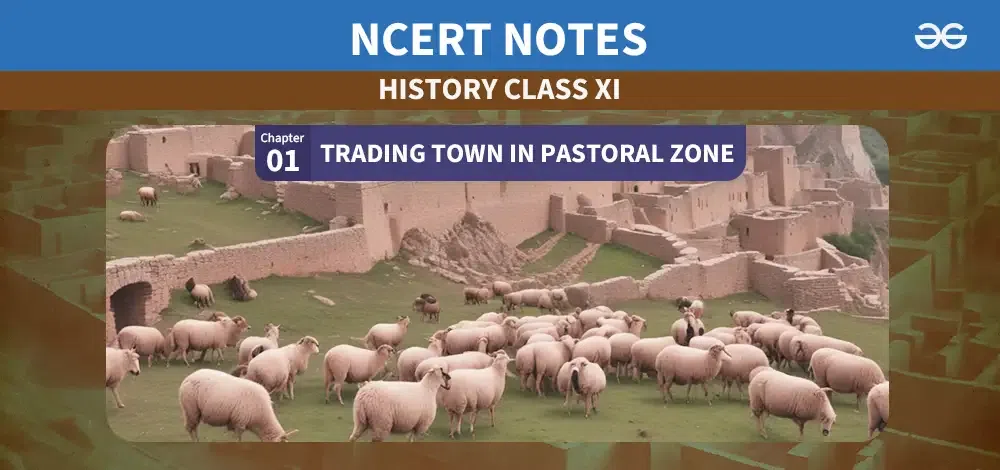Situated upstream on the Euphrates, away from the fertile southern plains, Mari emerged as a pivotal trading hub in the ancient world. Its strategic position facilitated commerce between pastoral communities and agricultural settlements, fostering a vibrant exchange of goods and services.
Let us learn more about trading town in pastoral zone!

Chapter 1: Trading Town in Pastoral Zone| Class 11 History Notes
Trading Town in Pastoral Zone
After 2000 BCE, the royal capital of Mari thrived, positioned upstream on the Euphrates rather than on the fertile southern plain. The region around Mari was used for both agriculture and animal husbandry, with communities engaged in both activities. While some territories had both farmers and herders, pastoralism dominated, with sheep and goats being the primary focus.
The coexistence of farmers and herders led to both cooperation and conflict. Herders exchanged animal products like young animals, cheese, and leather for grain and metal tools from farmers. However, conflicts arose when herds damaged crops or when herders raided agricultural villages. Settled groups sometimes denied pastoralists access to water sources, leading to tensions.
Throughout Mesopotamian history, nomadic groups from the western desert migrated into the agricultural heartland. These groups, such as the Akkadians, Amorites, Assyrians, and Aramaeans, initially arrived as herders, laborers, or mercenaries, eventually settling down and establishing their own rule. The kings of Mari were Amorites who integrated into Mesopotamian society, respecting its gods while also worshiping Dagan, the god of the steppe.
Trade played a vital role in Mari’s prosperity, situated at a strategic location for trade between the south and the mineral-rich uplands. Goods like wood, copper, tin, oil, and wine were transported along the Euphrates, with Mari serving as a trading hub. Officials inspected cargo and levied charges before allowing boats to continue downstream. Notably, Mari traded with “Alashiya” (Cyprus) for copper and tin, essential for bronze production, highlighting the city’s economic significance despite its limited military strength.
Interplay of Agriculture and Pastoralism
In the kingdom of Mari, agriculture and animal rearing coexisted harmoniously, with most of the territory devoted to pasturing sheep and goats. This symbiotic relationship between farmers and herders necessitated trade for mutual benefit, exchanging young animals, cheese, leather, and meat for grain and metal tools.
Challenges and Conflicts
However, tensions often simmered between herders and agriculturalists. Conflicts arose over access to resources such as water, with herders traversing sown fields, endangering crops. Additionally, the mobility of herders enabled them to raid agricultural villages, exacerbating distrust between settled and nomadic communities.
Nomadic Influx and Sociopolitical Dynamics
Throughout Mesopotamian history, nomadic groups from the western desert migrated into the agricultural heartland, seeking seasonal opportunities as herders, laborers, or mercenaries. Some, like the Akkadians and Amorites, rose to power, establishing their rule and influencing the cultural landscape of Mesopotamia.
Trade and Urban Prosperity
Mari’s prosperity stemmed from its strategic location for trade, serving as a conduit between the southern cities and the mineral-rich uplands of Turkey, Syria, and Lebanon.
Boats laden with goods such as wood, copper, tin, oil, and wine traversed the Euphrates, stopping at Mari for inspection and taxation before continuing downstream. Notably, Mari facilitated trade in copper from Cyprus and tin, vital components for bronze production, underscoring its economic significance.
Vigilance and Governance
Despite its economic prowess, the kings of Mari remained vigilant, overseeing the influx of herders into their kingdom. Surveillance of nomadic camps and preemptive measures against potential raids were commonplace, as reflected in historical records and correspondences between rulers and officials.
Conclusion
The story of Mari epitomizes the intricate interplay between trade, pastoralism, and sociopolitical dynamics in ancient Mesopotamia.
Through its strategic location, economic prosperity, and cultural openness, Mari emerged as a flourishing urban center, embodying the vibrancy and resilience of Mesopotamian civilization.
Trading Town in Pastoral Zone- FAQs
How did the coexistence of agriculture and pastoralism contribute to the economy of Mari?
The symbiotic relationship between agriculture and pastoralism in Mari facilitated a mutually beneficial exchange of goods and services. Pastoralists provided products such as young animals, cheese, leather, and meat in exchange for grain and metal tools from farmers, enriching the local economy.
What were some of the challenges and conflicts faced by herders and agriculturalists in Mari?
Tensions often arose between herders and agriculturalists over resource access, particularly water. Conflicts emerged when herds grazed on sown fields, damaging crops, or when herders raided agricultural villages for stored goods, highlighting the complexities of managing cohabitation in a diverse landscape.
How did nomadic influx influence the sociopolitical landscape of Mari?
Nomadic groups migrating into Mari, such as the Akkadians and Amorites, played a significant role in shaping its sociopolitical dynamics. Some rose to power, establishing their rule and contributing to the cultural mosaic of Mesopotamia, underscoring the fluidity of identity and governance in the region.
What were the key commodities traded through Mari, and why was it a prosperous trading hub?
Mari served as a crucial trading hub for goods such as wood, copper, tin, oil, and wine, facilitating commerce between southern cities and mineral-rich uplands. Its strategic location on the Euphrates enabled efficient transportation of goods, while taxation of trade further bolstered its economic prosperity.
How did the kings of Mari govern and manage the influx of herders into their kingdom?
The kings of Mari maintained vigilance over the influx of herders, monitoring nomadic camps and implementing measures to mitigate potential conflicts or raids. Historical records and correspondences between rulers and officials attest to the governance strategies employed to ensure stability and security within the kingdom.
Share your thoughts in the comments
Please Login to comment...